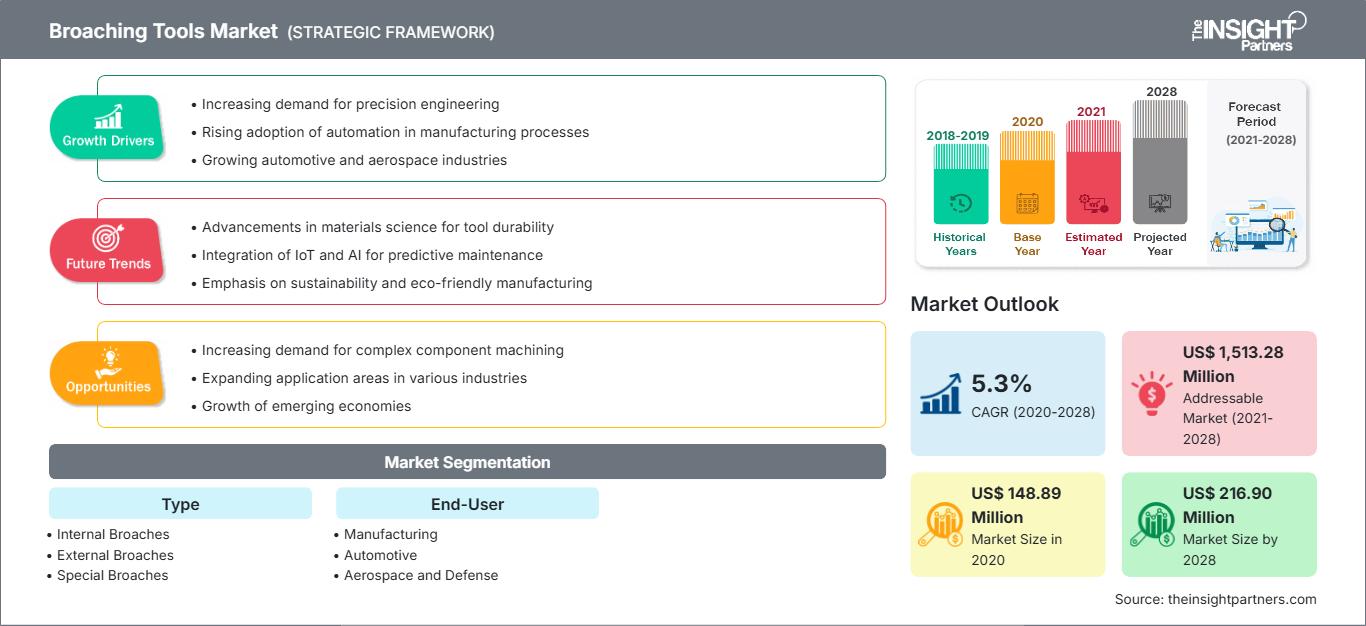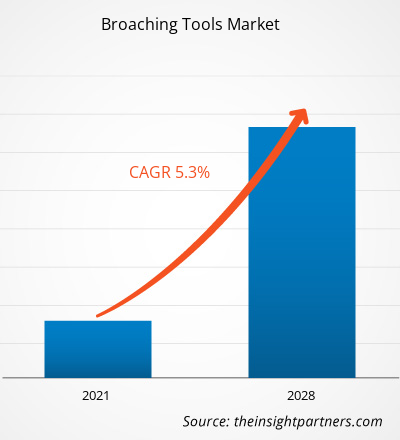Il mercato degli utensili per brocciatura è stato valutato a 148,89 milioni di dollari nel 2020 e si prevede che raggiungerà i 216,90 milioni di dollari entro il 2028; si prevede una crescita a un CAGR del 5,3% nel periodo 2021-2028.
Grazie alla crescita economica globale, il settore manifatturiero ha acquisito una notevole importanza negli ultimi due decenni, soprattutto nelle economie emergenti dell'Asia-Pacifico. Gli utensili per brocciatura sono ampiamente utilizzati per la produzione di vari componenti industriali e sottogruppi. La crescente domanda di processi di finitura ad alta velocità e precisione da parte di settori di utilizzo finale come l'automotive, l'aerospaziale e la difesa e l'edilizia sta incoraggiando i produttori di utensili per brocciatura a introdurre sul mercato utensili avanzati. Il settore manifatturiero è uno dei principali motori di crescita economica nell'area APAC. Fattori come il basso costo del lavoro, l'aumento della popolazione giovane e i benefici governativi sotto forma di filiali e incentivi fiscali attraggono le aziende a creare basi produttive più ampie nell'area Asia-Pacifico. Inoltre, iniziative governative come Made in China 2025 e Make in India stanno stimolando la crescita del settore manifatturiero nella regione Asia-Pacifico. Inoltre, l'aumento del reddito disponibile tra le masse sta portando alla crescente adozione di uno stile di vita moderno nella regione, alimentando la domanda di elettronica di consumo e automobili. Questo fattore sta rafforzando il settore manifatturiero. Pertanto, la crescita del settore manifatturiero sta trainando la crescita del mercato degli utensili per brocciatura nella regione APAC.
Personalizza questo rapporto in base alle tue esigenze
Potrai personalizzare gratuitamente qualsiasi rapporto, comprese parti di questo rapporto, o analisi a livello di paese, pacchetto dati Excel, oltre a usufruire di grandi offerte e sconti per start-up e università
Mercato degli utensili per brocciatura: Approfondimenti strategici

-
Ottieni le principali tendenze chiave del mercato di questo rapporto.Questo campione GRATUITO includerà l'analisi dei dati, che vanno dalle tendenze di mercato alle stime e alle previsioni.
Impatto della pandemia di COVID-19 sul mercato degli utensili per brocciatura
L'epidemia di COVID-19 sta influenzando negativamente i settori industriali in tutto il mondo e questo effetto devastante continua anche nel 2021. L'epidemia ha creato notevoli interruzioni in settori primari come la produzione, la sanità, l'energia e la potenza, l'elettronica e i semiconduttori, l'aerospaziale e la difesa e l'edilizia. Un significativo calo delle attività nei settori menzionati sta influenzando negativamente le prestazioni del mercato degli utensili per brocciatura. La reintroduzione di misure di contenimento, come restrizioni di viaggio, divieti commerciali e limitazioni della forza lavoro nei luoghi di lavoro, ha interrotto la produzione, la fornitura e le vendite di diverse aziende, comprese le attrezzature industriali come gli utensili per brocciatura.
Approfondimenti sul mercato degli utensili per brocciatura
Aumento della produzione automobilistica
Negli ultimi anni, si è registrato un aumento della domanda di automobili di fascia alta, con conseguente aumento della produzione di veicoli, principalmente nelle regioni sviluppate come Nord America ed Europa. Inoltre, la domanda di veicoli commerciali e autovetture, principalmente nei paesi in via di sviluppo, è in aumento. Gli utensili per brocciatura sono ampiamente utilizzati nel settore automobilistico per la produzione di ingranaggi, alberi di trasmissione, mozzi del volante, forcelle dello sterzo e altri componenti. Secondo il Center for Automotive Research, un'organizzazione no-profit, nel 2018 case automobilistiche come FCA, GM, Ford, Hyundai, Nissan, Volkswagen e Toyota hanno investito 4,8 miliardi di dollari nel settore automobilistico. Inoltre, gli investimenti del settore automobilistico in ricerca e sviluppo (R&S) sono aumentati del 6,7%, raggiungendo i 67,09 miliardi di dollari all'anno in Europa. Pertanto, la crescente domanda di veicoli di fascia alta e l'aumento della produzione di veicoli stanno stimolando l'adozione di utensili di brocciatura nel settore automobilistico.
Approfondimenti di mercato basati sulla tipologia
In base alla tipologia, il mercato degli utensili di brocciatura è segmentato in brocce interne, brocce esterne e brocce speciali. Il segmento delle brocce interne ha detenuto la quota maggiore nel 2020. Si prevede che il mercato delle brocce interne crescerà a un ritmo più rapido durante il periodo di previsione a causa della crescente domanda di brocciatrici verticali. La tecnica di brocciatura interna è ampiamente utilizzata per la produzione di vari componenti di precisione, come ingranaggi per automobili e macchinari, componenti per armi da fuoco e elementi di fissaggio. Con la costante crescita dell'industrializzazione in tutto il mondo, si prevede che il mercato degli utensili per brocciatura registrerà una crescita significativa durante il periodo di previsione.
Gli operatori del mercato degli utensili per brocciatura si concentrano su strategie come fusioni, acquisizioni e iniziative di mercato per mantenere le proprie posizioni sul mercato. Di seguito sono elencati alcuni sviluppi dei principali operatori:
- Nel 2020, Blohm Jung GmbH ha lanciato la PROFIMAT XT con cambio utensile. L'utensile consente il cambio automatico delle mole. Questa flessibile PROFIMAT XT unisce quattro tecnologie di rettifica in un'unica macchina: rettifica alternata, avanzamento lento, rettifica circolare e rettifica a corsa rapida.
- Nel 2018, Blohm Jung GmbH ha lanciato in anteprima mondiale all'IMTS il suo nuovo prodotto denominato PROFIMAT XT. Questo lancio rappresenta un'espansione del suo portafoglio di rettificatrici.
Mercato degli utensili per brocciatura
Le tendenze regionali e i fattori che influenzano il mercato degli utensili per brocciatura durante il periodo di previsione sono stati ampiamente spiegati dagli analisti di The Insight Partners. Questa sezione illustra anche i segmenti e la geografia del mercato degli utensili per brocciatura in Nord America, Europa, Asia-Pacifico, Medio Oriente e Africa, America Meridionale e Centrale.
Ambito del rapporto di mercato degli utensili per brocciatura
| Attributo del rapporto | Dettagli |
|---|---|
| Dimensioni del mercato in 2020 | US$ 148.89 Million |
| Dimensioni del mercato per 2028 | US$ 216.90 Million |
| CAGR globale (2020 - 2028) | 5.3% |
| Dati storici | 2018-2019 |
| Periodo di previsione | 2021-2028 |
| Segmenti coperti |
By Tipo
|
| Regioni e paesi coperti |
Nord America
|
| Leader di mercato e profili aziendali chiave |
|
Densità degli attori del mercato degli strumenti di brocciatura: comprendere il suo impatto sulle dinamiche aziendali
Il mercato degli utensili per brocciatura è in rapida crescita, trainato dalla crescente domanda degli utenti finali, dovuta a fattori quali l'evoluzione delle preferenze dei consumatori, i progressi tecnologici e una maggiore consapevolezza dei vantaggi del prodotto. Con l'aumento della domanda, le aziende stanno ampliando la propria offerta, innovando per soddisfare le esigenze dei consumatori e sfruttando le tendenze emergenti, alimentando ulteriormente la crescita del mercato.

- Ottieni il Mercato degli utensili per brocciatura Panoramica dei principali attori chiave
Il mercato globale degli utensili per brocciatura è stato segmentato come segue:
Mercato degli utensili per brocciatura - per tipo
- Brocce interne
- Brocce esterne
- Brocce speciali
Mercato degli utensili per brocciatura - per utente finale
- Produzione
- Automotive
- Aerospaziale e difesa
- Edilizia
- Altro
Mercato degli utensili per brocciatura - per area geografica
-
Nord America
- Stati Uniti
- Canada
- Messico
-
Europa
- Francia
- Germania
- Italia
- Russia
- Regno Unito
- Resto di Europa
-
Asia Pacifico (APAC)
- Cina
- India
- Giappone
- Australia
- Corea del Sud
- Resto dell'APAC
-
Medio Oriente e Africa (MEA)
- Arabia Saudita
- EAU
- Sud Africa
- Resto del MEA
-
Sud America (SAM)
- Brasile
- Argentina
- Resto di SCAM
Profili aziendali
- American Broach & Machine Company
- Arthur Klink GmbH
- Colonial Tool Group Inc.
- Ekin S coop
- Blohm Jung GmbH
- Messer Räumtechnik GmbH & Co. KG
- Mitsubishi Heavy Industries Machine Tool Co., Ltd.
- Nachi-Fujikoshi Corp.
- The Broach Masters, Inc.
- Miller Broach
- Analisi storica (2 anni), anno base, previsione (7 anni) con CAGR
- Analisi PEST e SWOT
- Valore/volume delle dimensioni del mercato - Globale, Regionale, Nazionale
- Industria e panorama competitivo
- Set di dati Excel
Report recenti
Testimonianze
Motivo dell'acquisto
- Processo decisionale informato
- Comprensione delle dinamiche di mercato
- Analisi competitiva
- Analisi dei clienti
- Previsioni di mercato
- Mitigazione del rischio
- Pianificazione strategica
- Giustificazione degli investimenti
- Identificazione dei mercati emergenti
- Miglioramento delle strategie di marketing
- Aumento dell'efficienza operativa
- Allineamento alle tendenze normative






















 Ottieni un campione gratuito per - Mercato degli utensili per brocciatura
Ottieni un campione gratuito per - Mercato degli utensili per brocciatura